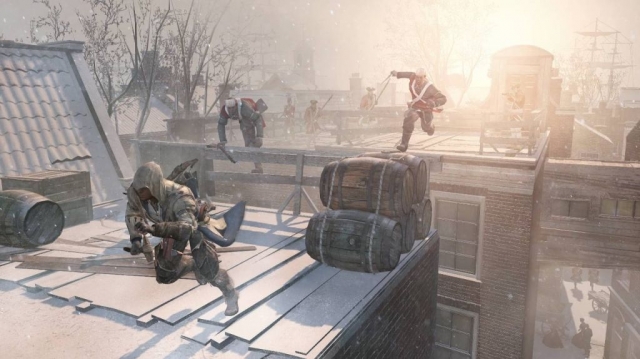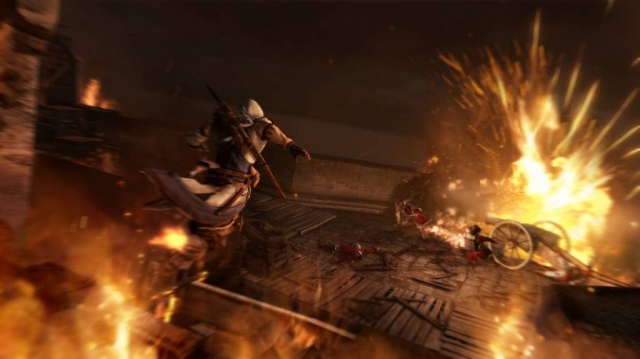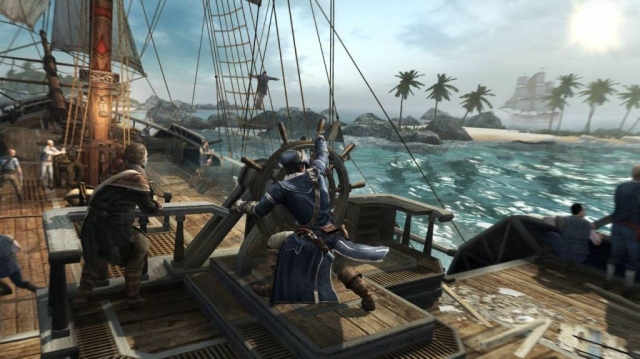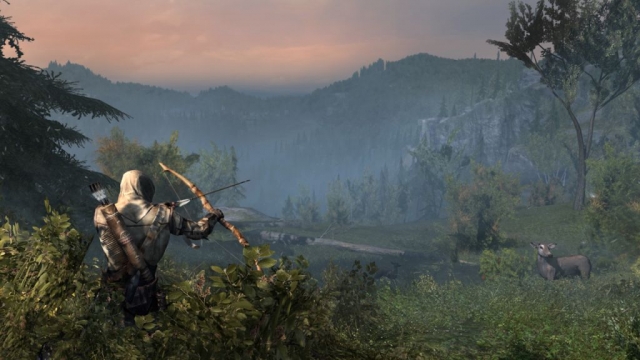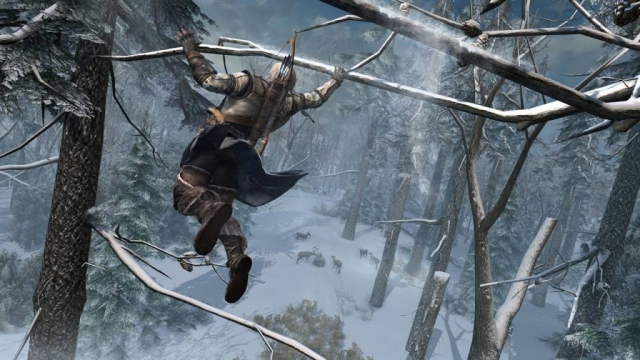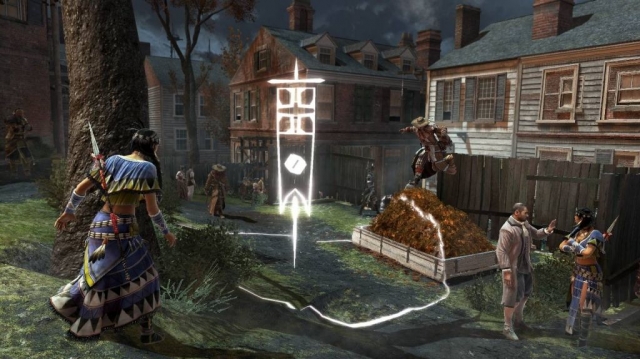Assassin’s Creed III Review

It’s hard to believe the Assassin’s Creed franchise, which debuted in November 2007, has existed entirely within the current console generation. How many other non-sports franchises can claim five installments within a single console generation (yeah, yeah, I see your hand up Call of Duty, it’s hard not to spot you sitting atop that giant pile of money)? What’s even more impressive is Ubisoft has released a new Assassin’s Creed title every year for the past four years and has still managed to maintain a superior level of quality (settle down Call of Duty, this isn’t about you). The latest installment promises to be the biggest yet. A new hero for the New World, this is Assassin’s Creed III.
Like every new Assassin’s Creed title, Assassin’s Creed III opens with a cinematic recap of the story so far. It’s a welcome refresher for those who have played through the entire series but let’s be honest, if you haven’t played all four previous Assassin’s Creed games to completion, or if this is your first foray into the Assassin’s Creed universe, you’re going to feel lost. The plot has become increasingly convoluted with each passing installment to the point where a story recap isn’t going to help those people much.
That being said, the writing continues to be one of the series’ strong suits. Once again Ubisoft has done their homework. It’s nothing short of remarkable how the writers have managed to marry the real-life history, locations and famous individuals of the American Revolution with the fictional power struggle between the Assassins and the Knights Templar. The fictional characters that have been added to the story are mostly unique and compelling, and the dialogue is believable and thought provoking on issues such as freedom, power and control.
I’ve heard some folks complain that the opening four to five hours of Assassin’s Creed III is drawn out. I couldn’t disagree more. Sure, some of the initial missions are a little dull, but in terms of the story, these are critical character-building moments. Without them, the early plot twist wouldn’t nearly be as intriguing or the emotional scene shortly thereafter as significant. These opening scenes provide incentive for the player to take action when they finally do don the hood of the protagonist.
The only weakness in terms of the writing is perhaps said protagonist – Ratonhnhaké:ton or Connor, as he’s later dubbed by his mentor, Achilles. Connor is a stark contrast to the charismatic Ezio Auditore da Firenze, the hero from the previous three Assassin’s Creed games. Connor has a bit of an angry streak in him, with good reason. Not only are his fellow Mohawk people being threatened and forced from their homes, he’s had to survive a very traumatic event from his childhood. These events have left him resentful and doubting of even his most staunch supporters. The result is a script that is considerably heavier than past Assassin’s Creed installments, with very few light-hearted moments.
Unfortunately, Desmond Miles continues to be his annoying self. It’s funny how the tables have turned on this character. I remember playing the original Assassin’s Creed, I use to rush through the Animus missions so I could back to the present day scenes, which I found to be much more intriguing. At the time, Desmond was an enigma, but then, in Assassin’s Creed II, his personality came to light. The beer goggles came off and Desmond was revealed to be an unbearably irritating character. It was then when the Assassin’s Creed series took a 180 for me. Now I was rushing through the present day interactions so I could jump into the Animus and spend some quality time with Ezio, my new Florentine friend. As bitter as Connor comes off, I’d still rather spend time with him than Desmond.
Another major highlight of Assassin’s Creed III is the game world, which has been meticulously crafted. You could literally spend hours walking the streets of Boston and New York, taking in the sights and sounds and visiting each of the cities’ numerous landmarks. You might even learn a thing or two about the American Revolution along the way. The game world is broken into four sections: Boston; New York; the Frontier, a large tract of countryside where most of the major battles of the American Revolutionary War take place; and Davenport Homestead, where your mentor Achilles resides. Put them together and you’ve got one giant open-world.
Assassin’s Creed III is without question the most action-oriented installment in the series to date. The core gameplay remains the same, but several new elements and systems have been introduced or expanded upon. Combat is still heavily focused on melee but with the introduction of muskets and rifles, gunplay is becoming more and more a factor as the series progresses. I’m not a huge fan of pressing a single button to fire a weapon and have it automatically hit your closest target, but considering how amazingly fluid combat feels when you combine gunplay and melee to pull off a series of kills, I’m willing to give it a hall pass for now. I also can’t express how much I enjoy the new dart rope. There’s nothing more rewarding then stringing an enemy up to a tree or lamppost. Sorry hidden blades, I have a new love affair.
Arguably the biggest new addition to gameplay is naval combat. I’ve never really been a fan of naval simulators but Assassin’s Creed III manages to make naval battles fun. There are a handful of naval missions within the campaign as well as a series of side missions for those who can’t get enough ship-on-ship action. Naval battles aren’t complicated at all, in fact they’re quite simple to manage, but they require a good deal of strategy to come away victorious and there’s no better feeling than sinking a fleet of enemy warships with a well-placed cannonball (except for that dart rope, oh how I love thee).
Free running continues to play a major role in Assassin’s Creed III. Anyone who has followed the game’s development knows that the parkour-like movement has extended beyond the city walls and into the wilderness. If I’m being honest, this addition feels a little forced at times. This might sound like a weird analogy but when you free run in a city, the environment feels like a spider web. There are all sorts of connecting paths that allow you to change directions on a whim. You can reach most destinations in a number of ways. In the wilderness, that spider web is often but a single strand, resulting in little to no room for improvisation. You can still maneuver around unnoticed and perform stealth kills, just don’t expect to move about the trees of the countryside like you would the rooftops of the city.
What would an Assassin’s Creed game be without exploration? Besides the main campaign, there are all kinds of side missions and activities to partake in, from liberating city districts to clearing enemy forts, from finding feathers to chasing almanac pages (why does the wind pick up EVERY time I get close to one?), from looting chests to recruiting new assassins, and from hunting animals to playing a game of Nine Men’s Morris at the local pub (a strategy board game that I am seriously addicted to), just to name a few.
Unfortunately, the side missions are the source of my biggest gripe with Assassin’s Creed 3. Sadly, they’re largely inconsequential. Allow me to give you an example. There are a series of Homestead missions that you can embark on that will see you rescue and recruit different settlers to work at Davenport Homestead. These settlers – tailors, miners, etc. – will then provide you with materials that you can use to craft items. “A crafting system that expands beyond bombs,” you might be saying, “how wonderful!” Yes, but allow me to continue.
You can find recipes throughout the game world, or you can try experimenting with different materials in hopes of crafting a new item. For instance, you might have a recipe to craft a barrel. To make a barrel, you need a Woodworker and oak lumber. What do you do with a barrel once you’ve made it? Well, if you’re Donkey Kong you might hurl it at Mario, but if you’re Connor you trade it for cash money. Here’s the catch, you don’t really need money in this game. I was able to complete the entire campaign without ever once purchasing a new weapon, without ever once needing to replenish my ammunition at the general store.
The crafting system is considerably deep, too. There are dozens of items that you can make besides a barrel, including weapons, munitions, clothing, medication, war supplies, inventions and much, much more. Some items can be used in-game, some are simply cosmetic, and still others are strictly to add coin to your pocket, but if crafting isn’t necessary to the progression of the game, what’s the incentive? I appreciate that the crafting and economic systems have been expanded upon, but I never felt compelled to craft anything throughout the campaign.
I think part of the problem lies with the enemies, who don’t get much tougher as the campaign advances. Sure, you’ll encounter some challenging adversaries, but it’s not so much a better weapon that’s required to defeat them as a different tactic. I guess what it boils down is this: When I finally finished the campaign and was set loose back into the world, the only interest I had left was to embark on one last naval mission and partake in one final match of Nine Men’s Morris.
Assassin’s Creed III is a much better game within the Animus than outside, and it’s not just because Desmond Miles is a whiny bitc… There’s a sequence outside of the Animus in which Desmond must infiltrate Abstergo’s office and rescue his father. This sequence is terribly executed. Not only is Abstergo’s office bland, the same character model is used for every guard in the joint (trust me, it’s hard not to notice). Luckily that character model is a terrible shot. Eventually you encounter a former Assassin-turned-Templar in what should be an epic showdown, but instead is a giant serving of weak sauce. As much as I enjoyed my experience within the Animus, the present day sequences lack the same excitement and polish.
Visually, Assassin’s Creed III is absolutely stunning. Boston and New York have been beautifully recreated, and the surrounding countryside is equally breathtaking in its vistas. Assassin’s Creed III is running on a new engine, the Anvil Engine, and everything from character models and animations, to lighting and particle effects are simply outstanding. Sound design is just as superb, highlighted by brilliant voice acting, amazing sound effects and a sweeping score. In terms of the presentation, the only drawback was the sheer number of technical issues I witnessed during my playtime. The bugs were numerous and included issues with lip-synching, texture pop-in, character disappearing and re-appearing at random (mostly when I was on horseback)…I even had to restart a mission once when a character I was following stopped dead in his tracks and refused to move. None of the bugs are game changing or game breaking, and it’s certainly not surprising to see some in a game of this size and scope. I just didn’t expect to encounter so many.
No longer just a training simulator for its soldiers, Abstergo has taken its Animus project to the masses, selling it as the next big gaming system through a series of live-action advertisements. Isn’t it interesting how developers are starting to explain the existence of multiplayer within their game’s universe? It’s nothing new to Assassin’s Creed, but it seems to be catching on with the likes of Halo following suit. New to multiplayer is a co-op mode called Wolf Pack, in which up to four players are tasked with killing certain NPCs during a time limit, through a sequence of 25 stages. Competitive multiplayer also sees a new addition in the form of Domination, a team mode where players capture areas of the map and then protect them from the opposing team. New characters, new maps and new sound cues round out what I’ve always felt was a very clever and unique take on multiplayer.
For those of you with a Wii U, you’ll be happy to know Assassin’s Creed III plays just as well on Nintendo’s new console (with just as many bugs), though it’s nowhere near as creative as some of Ubisoft’s other launch titles, like ZombiU or Rabbids Land. The Wii U Gamepad provides a larger, more detailed map, features the ability to change weapons on the fly without interrupting combat, and allows you to play the entire game on the touch screen. It would have been nice if they implemented a lockpick mechanic that utilized the touch screen (anything would have been better than the controller-based mechanic) or the ability to sift through the Animus database, but what’s here is nice.
This review is getting long-winded so let’s wrap it up. Assassin’s Creed III is the biggest and most ambitious Assassin’s Creed title yet, but a few missteps leaves it short of being the series’ best. In spite of my excessive nitpicking, Assassin’s Creed III is great game and a must-have for any Assassin’s fan.
Reviewed By: Stephen Riach
Publisher: Ubisoft
Rating: 88%
——————————————————————————–
This review is based on the PlayStation 3 version of Assassin’s Creed III provided by Ubisoft.
 Game Over Online
Game Over Online